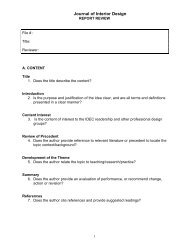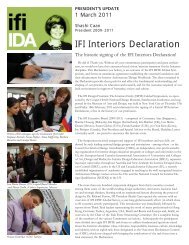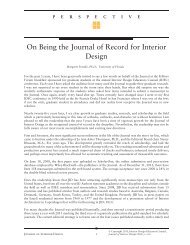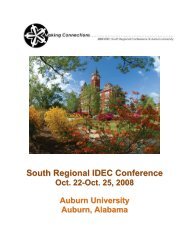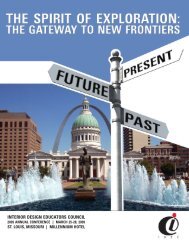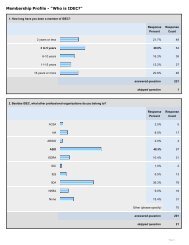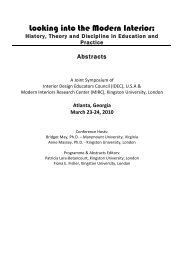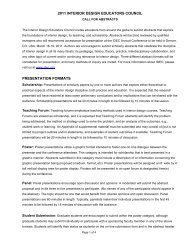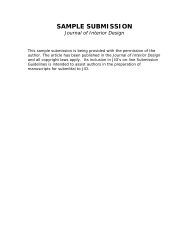A Natural Balance: Interior Design, Humans, and Sustainability
A Natural Balance: Interior Design, Humans, and Sustainability
A Natural Balance: Interior Design, Humans, and Sustainability
You also want an ePaper? Increase the reach of your titles
YUMPU automatically turns print PDFs into web optimized ePapers that Google loves.
P E R S P E C T I V EAs interior design evolves as a profession, we continue to grapple with identity <strong>and</strong> value. While we ourselvessee the value that we bring to the built environment, others do not. So we are often left out of importantdiscussions around the design table. Our active involvement with sustainability as it struggles to provideenergy efficiency without ignoring the human being can <strong>and</strong> will open doors for us to bring our mostvaluable interior design abilities <strong>and</strong> skills to the discussion—that of a person-centered focus. Of any barriers,constraints, <strong>and</strong> recognition, Penny Bonda, prominent writer, lecturer, <strong>and</strong> founding chair USGBC LEED forCommercial <strong>Interior</strong>s, said in 1994, ‘‘While the LEED system was being developed,’’ she recalls, ‘‘I mentionedthat maybe we should have a version for interiors. One of the [USGBC] board members said, ‘Why? <strong>Interior</strong>sdon’t matter.’ I said ‘Well, actually, that’s where the people are.’’’ (Gould & Hosey, 2007, p. 202).A small group of thoughtful people could change the world. Indeed, it’s the only thing that ever has.Margaret MeadReferencesBoecher, J., Horst, S., Keiter, T., Lau, A., Sheffer, M., Toevs, B., et al. (2009). The integrative design guide to green building: Redefining thepractice of sustainability. Hoboken, NJ: John Wiley & Sons, Inc.Chen, A. (2009). Berkeley Lab: Lawrence Berkeley National Laboratory. Working toward the very low energy consumption building of thefuture. Retrieved January 11, 2012, from http://newscenter.lbl.gov/feature-stories/2009/06/02/working-toward-the-very-low-energyconsumption-building-of-the-future/Choi Granade, H., Creyts, J., Derkach, A., Farese, P., Nyquist, S., & Ostrowski, K. (McKinsey & Company) (2009). Unlocking energyefficiency in the U.S. economy: Executive summary. Retrieved February 1, 2012, from McKinsey & Company website: http://mckinsey.com/USenergyefficiencyCole, R. (2012). Regenerative design <strong>and</strong> development: Current theory <strong>and</strong> practice. Building Research & Information, 40(1), 1–6. RetrievedFebruary 3, 2012, from http://dx.doi.org/10.1080/09613218.2012.617516Cole, R., & Brown, Z. (2009). Reconciling human <strong>and</strong> automated intelligence in the provision of occupant comfort. Intelligent BuildingsInternational, 1(1), 39–55. Retrieved February 3, 2012, from http://dx.doi.org/10.3763/inbi.2009.0007du Plessis, C. (2012). Towards a regenerative paradigm for the built environment. Building Research & Information, 40(1), 7–22.Envision <strong>Design</strong>, PLLC. (<strong>Design</strong>er) (2009). United States Green Building Council Headquarters [Print], Washington, DC.Gould, K., & Hosey, L. (2007). Women in green: Voices of sustainable design in green. Bainbridge Isl<strong>and</strong>, Washington: Ecotone LLC.Heerwagen, J., & Diamond, R. C. (1992). Adaptations <strong>and</strong> coping: Occupant response to discomfort in energy efficient buildings.Proceedings of ACEEE summer study on energy efficiency in buildings, Vol 10, Berkeley, CA, ACEEE, 83–90. Retrieved January 25,2012, from http://epb.lbl.gov/homepages/Rick_Diamond/Coping_aceee_92.pdfHeerwagen, J., Gray, W., & Loder, A. (2011, October). In J. Heerwagen (Chair). Why research matters: New approaches to measuregreen building <strong>and</strong> workers’ health, stress <strong>and</strong> productivity. Paper presented at Greenbuild® conference & expo.Kupritz, V. W. (2000). A conceptual model of privacy regulation for hrd <strong>and</strong> organizations. Journal of Industrial Teacher Education, 38,29–59. Retrieved February 7, 2012, from http://www.cci.utk.edu/node/8929Mang, P., & Reed, B. (2012). <strong>Design</strong>ing from place: A regenerative framework <strong>and</strong> methodology. Building Research & Information, 40(1),23–38. Retrieved February 15, 2012, from http://dx.doi.org/10.1080/09613218.2012.621341Margaret Mead Speaks at First Earth Day. (2012). The History Channel website. Retrieved 1:20, March 3, 2012, fromhttp://www.history.com/audio/margaret-mead-speaks-at-first-earth-day.Nicol, F. (2011). Adaptive comfort. Building Research & Information, 39(2), 105–107.Piedmont-Pall<strong>and</strong>ino, S. (2012, January 26). Interview by L Sorrento [Personal Interview]. Technology <strong>and</strong> human debate.Pyke, C. (2011, August 12). Interview by L. Sorrento [Personal Interview]. Different perspectives applied to high performance buildings.Pyke, C. U.S. Green Building Council (2012). Using information technology to transform the green building market. Washington, DC: U.S.Green Building Council.Journal of <strong>Interior</strong> <strong>Design</strong> xxi Volume 37 Number 2 2012





